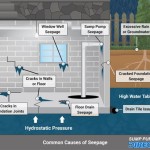Cost to Dig Out Basement 2 Feet: An Essential Guide
Are you planning to create a more spacious and comfortable living space by digging out your basement 2 feet? Understanding the potential costs involved is crucial for proper planning. This article will provide an overview of the essential factors that influence the cost of digging out a basement, helping you make informed decisions.
1. Size and Scope of the Project
The overall cost will depend on the size of your basement and the scope of work required. A larger basement will require more excavation, which will increase the cost. Additionally, factors such as the number of walls to be moved or reinforced, the presence of utilities, and the need for additional support structures will impact the project's overall cost.
2. Soil Conditions
The type of soil in your area will play a significant role in determining the cost of excavation. Harder soils, such as clay or rock, will be more challenging to remove, requiring specialized equipment and increased labor costs. Conversely, softer soils, such as sand or loose dirt, will be easier to dig out, reducing the overall expense.
3. Building Permits and Inspections
Obtaining the necessary building permits and inspections is often a requirement for basement excavation projects. Permit fees vary depending on your local building codes, and inspections may be necessary to ensure the work meets safety and construction standards. It's important to factor these costs into your budget.
4. Labor Costs
The cost of labor will typically be one of the largest expenses associated with digging out your basement. The number of laborers required, their skill level, and the complexity of the work will influence the total cost. It's recommended to get quotes from multiple contractors to compare labor rates.
5. Materials and Equipment
Excavating a basement requires various materials and equipment, including tools, supports, concrete, and backfill. The cost of these materials will vary depending on the quality, quantity, and availability in your area. Additionally, some projects may require specialized equipment, such as excavators or pumps, which can increase the overall cost.
6. Drainage and Waterproofing
Ensuring proper drainage and waterproofing is crucial to prevent moisture problems in your basement. Installing drains, sump pumps, and waterproofing membranes will add to the total cost of the project. However, these measures are essential for protecting your basement from water damage and maintaining a comfortable living space.
7. Finishing Touches
After the excavation is complete, you may need to add finishing touches to the basement, such as framing, drywall, flooring, and lighting. These elements will enhance the functionality and aesthetic appeal of your basement but will also add to the overall cost.
Conclusion
The cost to dig out a basement 2 feet can vary depending on several factors. By considering the size and scope of the project, soil conditions, building permits, labor costs, materials and equipment, drainage and waterproofing, and finishing touches, you can create a comprehensive budget and plan for the successful completion of your basement excavation.

Cost Of Underpinning Rcc Waterproofing Blog

Find Out Digging Basement Cost Savvy

What Is The Cost To Dig Out A Basement 2024 Guide

Cost Of Underpinning Rcc Waterproofing Blog

Cost Of Underpinning Rcc Waterproofing Blog

Basement Underpinning Toronto Lowering
Basement Dig Out New Sim Build Golf Simulator Forum

A Huge Decision On The Basement To Dig Or Not Our Old Rowhouse

How A Basement Digout Is Done By Hand

A Comprehensive Guide To Basement Excavation Cost Greenbar
See Also








